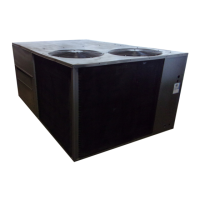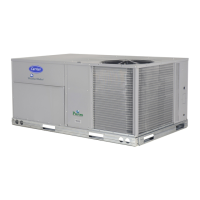NOTE: Remove 620-ohm resistor if differential enthalpy sen-
sor is installed.
Indoor Air Quality (IAQ) Sensor Input -- The IAQ input
can be used for demand control ventilation control based on the
level of CO2 measured in the space or mtum air duct.
Mount the accessory IAQ sensor according to manufacturer
specifications. The IAQ sensor should be wired to file AQ and
AQI terminals of file controller Adjust the DCV potentiome-
ters to correspond to file DCV voltage output of the indoor air
qufflity sensor fit the usel;determined set point. See Fig. 37.
If a separate field-supplied transfon3rler is used to power the
IAQ sensor, the sensor must not be grounded or the
EconoMiSerIV control board will be &imaged.
Exhaust Set Point Adjustment -- The exhaust set point will
determine when the exhaust fan runs based on damper position
(if accessory power exhaust is installed). The set point is modi-
fied with the Exhaust Fan Set Point (EXH SET) potentiometel:
See Fig. 32. The set point represents the dm3rlper position above
which the exhaust fan will be turned on. When them is a call
for exhaust, the EconoMiSerIV controller provides a 45 _+ 15
second delay before exhaust fan activation to allow the damp-
ers to open. This delay allows the damper to reach file appro-
priate position to avoid unnecessary fan overload.
Minimum Position Control -- There is a minimum damper
position potentiometer on the EconoMiSerIV controllel: See
Fig. 32. The minimum dmnper position maintains the mini-
mum airflow into the building during the occupied period.
...........................TR
v'ac DM
EF_ _F1
..../
Fig. 36- EconoMi$erlV Controller
6000
5000
z
_o 4000
rr
---. 3000
Lk
z
oO 2000
IJJ
(5
z 1000
<
rr
CO2 SENSOR MAX RANGE SETTING
+ 800ppm
+1100 ppm
o
2 3 4 5 6 7 8
DAMPERVOLTAGEFOR MAX VENTILATIONRATE
Fig. 37 -- 002 Sensor Maximum Range Setting
When using demand ventilation, the minimum dm3rlper po-
sition represents the minimum ventilation position for VOC
(volatile organic compound) ventilation requirements. The
maximum demand ventilation position is used for fully occu-
pied ventilation.
When demand ventilation control is not being used, the
minimum position potentiometer should be used to set the oc-
cupied ventilation position. The maximum demand ventilation
position should be turned fully clockwise.
Adjust the minimum position potentiometer to allow the
minimum amount of outdoor ail, as required by local codes, to
enter the building. Make minimum position adjustments with
at least 10 ° F temperature difference between file outdoor and
return-air temperatures.
To determine the minimum position setting, perform the
following procedure:
1. Calculate the appropriate mixed-air temperature using the
following formula:
OA RA
(To x l-T0-0- ) + (TR x l-T00- = TM
To = Outdoor-Air Temperature
OA = Percent of Outdoor Air
TR = Return-Air Temperature
RA = Pement of Return Air
TM = Mixed-Air Temperature
As an example, if local codes require 10% outdoor air
during occupied conditions, outdoor-air temperature is
60 E and return-air temperature is 75 E
(60 x. 10) + (75 x .90) = 73.5 F
2. Disconnect the supply-ffir sensor from temlinals T and
TI.
3. Ensure that the factou-installed jumper is in place across
terminals P and Pl. If remote damper positioning is being
used, make sure that the terminals are wired according to
Fig. 30 and that the minimum position potentiometer is
turned fully clockwise.
4. Connect 24 vac across terminals TR and TRI.
5. Carefully adjust the minimum position potentiometer
until the measured mixed-air temperature matches the
calculated vfflue.
6. Reconnect the supply air sensor to terminals T and TI.
Remote control of the EconoMi$erIV damper is desirable
when requiting additional tempora U ventilation, ff a
field-supplied remote potentiometer (Honeywell pfu-t number
$963B1128) is wired to the EconoMi$erIV controllen the min-
imum position of the &unper can be controlled from a remote
location.
To control file minimum damper position remotely, remove
file factou-installed jumper on file P and PI terminals on the
EconoMi$erIV controller Wire the field-supplied potentiome-
ter to the P and PI terminals on the EconoMi$erIV controllen
See Fig. 36.
Damper Movement -- Damper movement from full open to
lull closed (or vice versa) takes 21/2 minutes.
Thermostats -- The EconoMi$erlV control works with con-
ventional thermostats that have a YI (cool stage 1), Y2 (cool
stage 2), WI (heat stage 1), W2 (heat stage 2), and G (fan). The
EconoMi$erIV control does not support space temperatme
sensors. Connections fue made at the themlostat terminal con-
nection board located in file main control box.
Occupancy Control -- The facto U default configuration for
the EconoMi$erIV control is occupied mode. Occupied status
is provided by the red jumper from terminal 9 to terminal 10 on
TB2. When unoccupied mode is desired, install a field-
supplied timeclock function in place of the jumper between
23

